(Credit for the text on this page to Sam McGowan)
This page is dedicated to the men of TIDAL
WAVE.
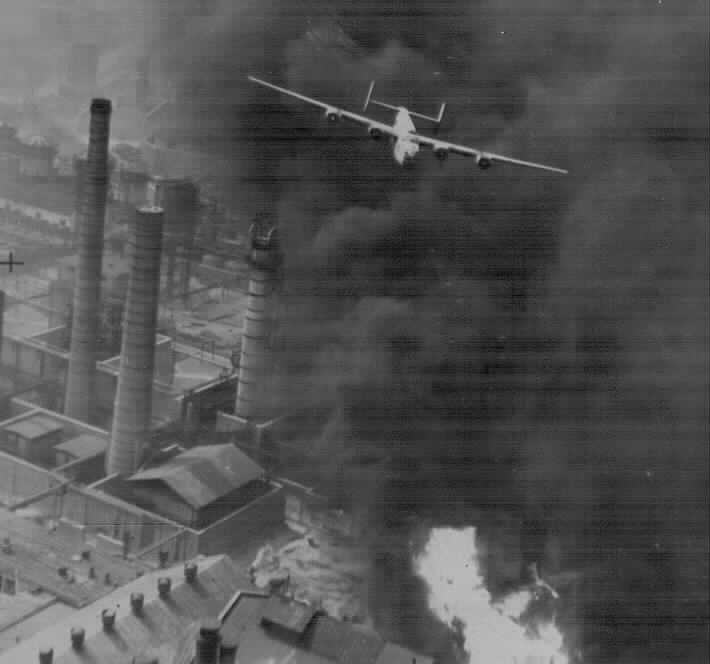
BLACK SUNDAY!
Ploesti! No other name from World War II promotes thoughts of courage and sacrifice on the part of US Army Air Forces bomber crews. Even the infamous mission to Schweinfurt where some 60 B-17s and their crews met their fate fails to compare with the low-level attack on the Romanian oil fields at Ploesti, Rumania on that terrible Sunday, August 1, 1943. No other group in the history of aviation has ever been sent out with the expectations of accomplishing so much, only to come face-to-face with near-disaster. Of 177 B-24 Liberators that took off from the airfields around Benghazi, Libya that day, 53 failed to return. Of the 88 that made it back, 55 suffered battle damage. Of the 1,765 men who flew the mission, 446 were killed or MIA and more than 100 were wounded.
The oil refineries at Ploesti became a target at the very beginning of World War II. Russian bombers attacked the refineries in 1941, but did little damage. On June 11, 1942 Ploesti was the target for the first American bombing mission against European targets when 13 B-24s of the "Halverson Project" were sent out to attack the Astro Romana refinery. The airplanes and crews were the remnants of a 23-airplane force that left Florida a few weeks before bound for India to bomb Tokyo, but when the mission was cancelled they were ordered to remain in North Africa and bomb targets in the Balkans. Twelve of the thirteen airplanes bombed the target, though little to no damage was done to the refineries. (There is some question that they even found the target.) A second mission was flown against the Italian fleet. The Halpro airplanes remained in North Africa and eventually became part of the 376th Bombardment Group when it activated later in the year.
Located in the foothills of the Alps in the region most famous as the home of the mythical character, Count Dracula, Ploesti was considered to be one of the most important strategic targets of World War II. As the site of the first commercial oil refineries in the world, by 1942 the city was producing as much as one third of the aviation fuel and other POL products used by the Germans. Many airmen believed that a "knock-out blow" could put the refineries out of business and severely cripple the Axis war machine at a time when the war was going very much against the Allies. Rumania itself was allied with the Axis, and was at war with the United States, though Ploesti itself was pretty much under the control of a German Luftwaffe officer, Colonel Alfred Gerstenberg. Prompted by an early Russian attack on the city, Gerstenberg built up the defenses around the city by bringing in German antiaircraft units and Luftwaffe fighters to make Ploesti a veritable redoubt. At the same time, the innovative German officer had constructed a pipeline system around the entire refinery system that would allow production to continue even if one or more of the major refineries in the complex - all of which were owned by competing commercial enterprises - were knocked out of action. But Allied intelligence was unaware of both the build-up in defenses and the steps that had been taken to reinforce the refineries' capabilities. Though remote, at the very edge of the range of the B-24 Liberators that were the only airplanes capable of striking them, the oil refineries were considered by Allied planners to be an easy target.
The plan for a massive attack on Ploesti originated at the Casablanca Conference in early 1942. Though a contingent of the planners counted such an attack as "a panacea," their objections were overruled and the conference ended with an attack on Ploesti as an approved project. The attack was supposed to take place after the North African campaign came to an end and before the planned landings on Sicily later in the year, but in fact came afterwards. As the closest unit to the refineries, the Ninth Air Force in North Africa was given the mission, which had been given the code name "TIDAL WAVE." Planning for the mission was conducted in the United States, with Colonel Jacob Smart in charge. Smart met with a British intelligence officer who had formerly managed the Astro Romania refinery, and learned that there were not enough bombers available to hit the entire complex. He and the Briton, Lt. Colonel W. Lesley Forster, decided on five major refineries as targets. Smart, who planned to go on the mission, came up with the plan for a low-altitude mission. His reasoning was that a zero-altitude attack would not only gain the element of surprise, it would allow greater bombing accuracy and would lessen the effectiveness of fighter attacks while at the same time putting each individual airplane in range of flak batteries for much less time than if they came over at high altitude.
In the summer of 1943 there were five B-24 groups in the ETO, three in England and the 98th and 376th in Africa. Previously, the 93rd Bomb Group had come down from England to assist the fledgling Ninth Air Force during the North African campaign. "The Circus" was pulled off of Eighth Air Force combat operations along with its sister 44th BG, and began low-level training in England with the 389th BG which had just arrived in England from the United States. All three groups then flew south to North Africa to join the Ninth Air Force groups at airfields around Benghazi, Libya. There the England-based Liberator groups joined the 98th and 376th in operations around the Mediterranean and training flights in preparation for Tidal Wave. Specific targets were assigned to each of the five groups. The Romana American plant was assigned to the 376th, the Concordia Vega plant to the 93rd, the Astro Romana refinery was the responsibility of the 98th BG and the 44th BG was to hit the Columbia Aquila refinery. A second wave of the 93rd was assigned the Standard and Unirea units. Each target was designated with the code name White and given a numerical designation from one to five. Two other refineries that lay outside the Ploesti complex at Campina and Brazov were designated as Red and Blue. They were to be hit by the 389th BG and an element of the 44th BG, respectively.
After several weeks of low-level training against a mock target set up in the Libyan desert, the Tidal Wave force took off from its bases around Benghazi early on the morning of Sunday, August 1, 1943. One airplane lost an engine right after takeoff and crashed in the desert. Another inexplicably crashed into the sea as the formation was passing over the Mediterranean. The Americans were hoping to arrive in enemy airspace undetected, but somehow the German air defenses got word very early in the day that a large bomber force had taken off from North Africa and was headed toward Europe. Air defense forces throughout the Mediterranean region were alerted that a raid was in progress, though the actual target was not known. Included among those notified were the air defense units responsible for the sectors including the Ploesti region. Instead of achieving total surprise, the men of Tidal Wave were about to fly into the heaviest concentration of antiaircraft guns in the world! And the guns were supported by fighters.
As the formation flew toward their destination, a huge gap began to develop between the lead groups, the 376th and 93rd, and the trailing 98th, 389th and 44th. The gap widened, perhaps because of the inability of the desert-weary and sand-scarred Liberators of the 98th group to maintain the airspeed of the leading groups. As the formation neared Albania, they encountered cumulus clouds over mountains. The formation leader, Colonel K.K. Compton of the 376th, elected to lead the formation through a gap in the clouds in an in-trail formation. But when the trailing groups, led by Col. John R. Kane, reached the same clouds, he elected to use published "Frontal Penetration" techniques which involved a massive circle with each element of three airplanes peeling off and entering the weather. The procedure was time consuming, and led to a greater separation between the two formations of Tidal Wave.
By the time the Liberators approached Romanian air space, the defenders of Ploesti were pretty sure they were the target. But as the four-engine bombers dropped back on the deck for the final run-in to the target, the German radar lost them, causing some confusion among the defenders. The attackers then became confused when the mission leader, Col. Compton, took a wrong turn at Targoviste, which was the second of three Initial Points that had been selected as check points for the mission. The turn toward Ploesti was supposed to be made at the third point, the village of Floresti; taking the heading too soon pointed the Tidal Wave force toward Bucharest. Even though the crews following him recognized the error and called a warning to their leader, Compton continued on the erroneous heading while one airplane, "Brewery Wagon," went off toward Ploesti by itself.
The 93rd Bomb Group was the second in the formation. Like most of the other crews, the group leader, Colonel Addison Baker and his copilot, Major John Jersted, recognized Compton's error. As they passed abeam Ploesti, Baker saw the stacks of the refineries through haze to his left ; he decided to forsake combat discipline and began a left turn to lead his group to become the first over the target. But since they were coming in from a different direction then planned, the 93rd commander was unable to determine his assigned target so he led his men over White Five, which was the target assigned to the 44th. The wrong turn not only caused confusion among the crews, it placed the Liberators along a path that the German defenders had anticipated as the most likely for an attack, and where they had placed their heaviest anti-aircraft defenses. The men of the "Travelling Circus" found themselves flying into a hell filled with barrage balloons and flak of every sort. At the extremely low altitudes at which they were flying, the Liberators were exposed to all calibers of guns, including the 20 and 37-mm cannon that were so effective at low altitudes. The gunners on board the airplanes dueled with the German and Romanian gunners on the ground, and shells from both sides flew into the containment tanks surrounding the refineries and set fires which turned the sky over the city into darkness. Even before the first bomb detonated, the sky over Ploesti became a sea of flames. Airplane after airplane was mortally wounded by the enemy flak, including John Jerstad's "Hells Wench." Jerstad and Baker would be posthumously awarded the Medal of Honor for leading the group over the refineries in a burning airplane.
To the right of Baker's formation, Major Ramsey Potts was leading B Force of the 93rd. Unable to find his assigned targets, he led his force over the Astro Romania refinery, the largest in the complex and the most important, which had been assigned to the 98th BG. To this point, the German and Romanian fighter had yet to find the Liberators, but as the surviving green ships of the 93rd came off the target they found themselves under fighter attack that added to the horrendous losses encountered in the flak over the city. As the 93rd left Ploesti, Lt. Col. George S. Brown, who was now commander after the death of Baker, could count only 15 airplanes left of the 39 93rd B-24s that had taken off from Benghazi that morning.
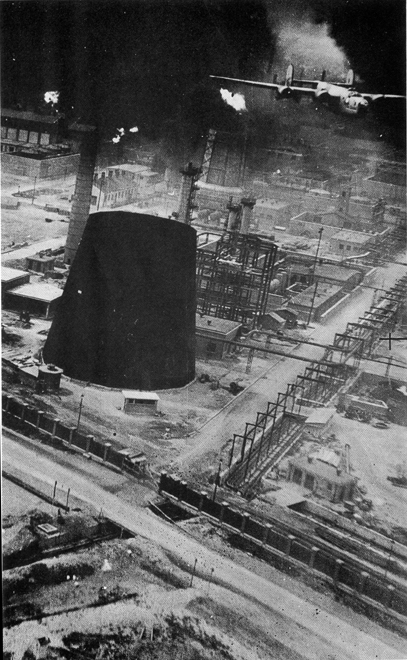
Meanwhile, Compton had recognized his error, but decided there was no way he could lead his group over the refineries as an effective force. Under instructions from the mission commander, BGen. Uzal Ent, who was flying with him in "Teggie Ann," he released the bombers to attack "targets of opportunity." As a result, the 376th suffered the lowest casualties of any of the groups on the mission; only two of the group's airplanes were shot down over the target. His group had been assigned to hit the American-owned Romana American refinery, which was considered a priority target because of the propaganda value if it were not bombed. As it turned out, it wasn't. The 376th Liberators dropped their bombs on whatever they thought might be a target, with one exception. Major Norman Appold, an aggressive pilot, led an element of five airplanes over the refineries toward the Concordia Vega complex, which had been the 93rd's original target. Coming in right down on the deck, Appold's men managed to knock out an estimated 40% of the refinery's capacity after almost colliding with the remnants of Pott's 93rd force and the lead element of Kane's second wave, which had just reached Ploesti and was beginning it's attack. Miraculously, the three groups of Liberators missed each other! German observers on the ground thought it was planned, and marvelled at the American's timing.
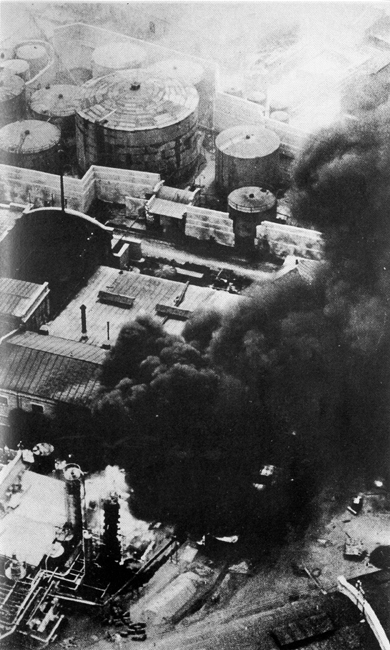
"Killer" Kane arrived at Ploesti to discover that Ramsey Pott's attack had turned it into a sea of flames. He elected to hit the target again, which was a wise decision considering that most of the smoke and flames over the city at that point was from burning gasoline held in storage tanks that had been set fire. Many of the bombs that had been dropped featured delayed action fuses and had yet to explode (while German bomb disposal squads were disarming many.) On their run-in, Kane's force parallelled a railroad, on which the Germans had dispatched a flak train. The German gunners poured their fire into the low-flying B-24s while the American gunners replied with their .50-calibers. Kanes' 98th Bomb Group lost 22 airplanes over Ploesti, but managed to destroy half the refining capacity of their target. The most effective attack of the day was that of B Force of the 44th Bomb Group, who hit the Creditul Minier Refinery five miles south of the city. The 21-airplane force, led by Colonel James Posey, managed to completely destroy the refinery while suffering only two losses. Posey's strike complimented that of his boss, Colonel Leon Johnson, whose A Force bombed White Five, which had already been hit by the 93rd airplanes under Addison Baker. The combined 93rd/44th attack knocked the Columbia Aquila refinery out of production for almost a year.
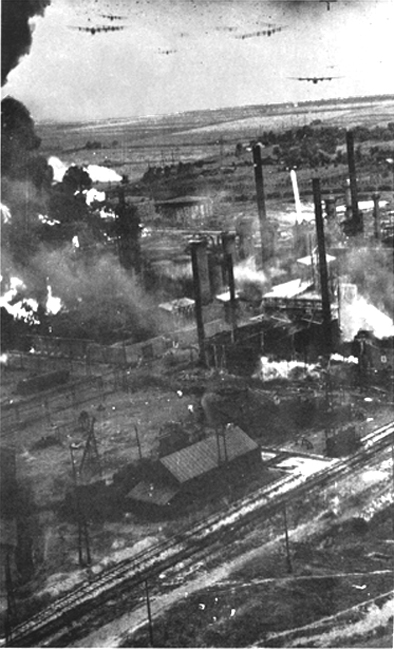
The 389th Bomb Group, which was new to combat, was assigned the refinery complex at Campina, 18 miles northwest of Ploesti. Colonel Jack Woods, the 389th commander, made a similar error as that of Compton when he took a wrong turn when his crew was unable to see a monastery which was a scheduled check point. Woods led his formation down a ravine out of the Alpine foothills as his calculations told him they were at the right place. When he saw the town of Tragoviste, he realized his error and turned back toward his target. Fortunately, even though his men had detected the error, they had maintained discipline and were still behind him. In spite of flak that brought down six airplanes, the 389th made one of the two as-planned attacks of the day. The Steaua Romana refinery was completed destroyed and did not resume production until the end of the decade!
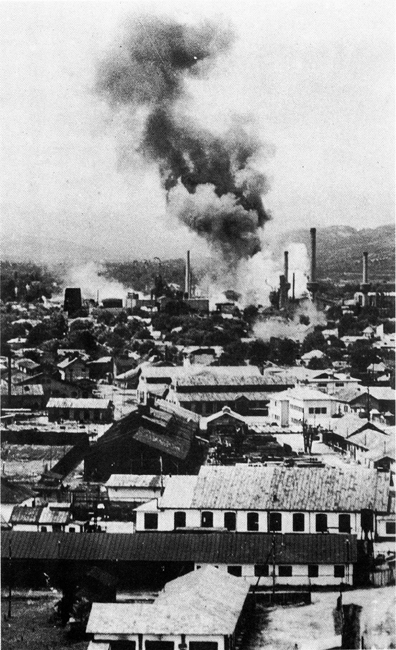
After coming off the target, the Liberator crews still faced swarms of German and Romanian fighters while many airplanes were badly damaged from flak. Nearly all of the Liberators that were shot down by fighters were lost after they had bombed. Fortunately, the low altitudes afforded some safety since the enemy fighters could only come at them from above. More than one fighter crashed into the ground while trying to attack at low altitude. Eventually the fighters' fuel supply caused them to break off their attacks, leaving the airmen to cope with the damage that had been done to their airplanes as they made their way back toward North Africa. Many of the airplanes were too badly damaged to make it home. Some, including Colonel Kane, headed for the RAF bases on Cyprus while others took course for Turkey. Some bombers made it to the blue waters of the Mediterranean where the crews ditched, and those who survived the ditchings waited for rescue. While most of the airplanes had already suffered battle damage, there were more fighter attacks along the way. One attack came in the vicinity of Sofia, in Bulgaria, and resulted in the loss of two Liberators. But the worst battle took place out over the Mediterranean when Messerschmitts flying out of Greece intercepted twelve B-24s over the Ionian Sea. The fighters shot down three B-24s and damaged another so badly that the crew had to ditch off of Crete.
While the Ploesti mission was not planned to be daring or exceptionally dangerous, it turned out to be that way. Allied hopes for a surprise attack were misplaced, though the crews themselves knew that they would likely be facing the most difficult day of their entire life when they went to bed the night before the mission. Some knew it would be their last day, while others were afraid it might be. The end result of the mission was considerable damage to the refining capacity of the Ploesti refineries, but Tidal Wave was not the "knock-out blow" it had been conceived to be. An Allied team, who surveyed the damage based on reconnaissance photos, determined that while the attack had not destroyed the refineries production capabilities, it did deprive the Germans of the "cushion" they had previously enjoyed in terms of fuel ability. This lack of "cushion" was the beginning of the decline of the Luftwaffe.
As for the crews who flew the mission, their heroism as they attacked the targets is perhaps beyond compare. The crews of the 93rd Bomb Group saw their commander shot down and both of his wingmen shot to pieces before the first bomb was even dropped on the target as a wall of flak came up to greet the low-flying Liberators. Yet they followed the ill-fated crews over the target and dropped their bombs. Other elements suffered heavily as they, too, flew into the flames and smoke of the Hell of Ploesti. Only one airplane of the last element in Kane's 98th BG came out of the smoke; five others were shot down over the target. The crews were complimented by the Romanians for their unprecedented bombing accuracy and their refusal to attack civilians. Prior to Ploesti, the wide bombing patterns of the high altitude raids that so many of the USAAF leaders were out to prove often missed their targets entirely and killed thousands of civilians in occupied countries. At Ploesti there were more casualties among the American aircrewmen then there were among the Romanian citizens on the ground, a fact that led to an almost plush life for the Liberator crewmen who were confined in Romania after being shot down over the target.
What is perhaps most important to remember about Ploesti is that the men who fought and died there were for the most part very young men. Though airmen in today's military tend to be well into their twenties, in 1943 the Army Air Forces was training boys who were still in their teens as pilots, navigators, bombardiers, radio operators, flight engineers and gunners. The low-level attack on Ploesti called for every ounce of courage within their character. The men who flew the mission deserve to be called "heroes." There were five Medals of Honor awarded for Tidal Wave. Two went to Colonels Johnson and Kane for leading their groups into the flames over their assigned targets after they had been previously bombed by the 93rd. Eventually Addison Baker and John Jerstad were awarded the medal posthumously, even though Baker's turn was criticized by some - including mission leader BGen. Uzal Ent - as a breach of combat discipline. The fifth medal went to Lt. Lloyd "Pete" Hughes, who maintained formation and bombed Red Target after his airplane had been turned into a "blowtorch" when the gasoline from his Tokyo Tank ignited. Hughes's award came only because of the persistence of an intelligence officer who persisted in tracking down witnesses to the episode.
After Tidal Wave, there was a hiatus in the attacks against the refinery. Never again would the USAAF send bomber crews against such a target at low altitude, but in April, 1944 the Fifteenth Air Force, which had replaced the Ninth Air Force in the Mediterranean, began a campaign to bomb the remnants of the Ploesti refineries into oblivion. Attacks were flown against Bucharest and Brasov, but it was not until May that Ploesti itself was bombed again. A new campaign against Romanian oil continued until August, 1944 when the Russian Army reached the oil fields. The 1944 attacks included not only B-24s of the Fifteenth Air Force flying from bases in Italy, but also B-17s from the same group. British RAF Lancasters also attacked Ploesti, and on one occasion USAAF P-38 fighters attacked at low-altitude to drop 1,000 pound bombs. The P-38s fared almost as badly as had the Tidal Wave force - 26 of the 46 bomb-laden twin-engine fighters were shot down when they were attacked by Messerschmitts before they could drop their bombs. Colonel Jacob Smart, who was originally supposed to have flown on Tidal Wave, was shot down during a Fifteenth Air Force mission against Weiner-Neustad, Austria. Smart, along with General Brereton and Colonel Ted Timberlake, had been ordered not to fly the low-level mission at the last moment. Smart, who was privy to the secret of the Atomic Bomb, was lost when his B-17 exploded. He was believed dead but turned up as a POW at the end of the war. Fortunately, he was never asked about nuclear fission.
The campaign against Romanian oil cost the United States 286 B-24s and B-17s and 2,829 of their crewmen killed or captured. The RAF lost 38 of its bombers on night missions.